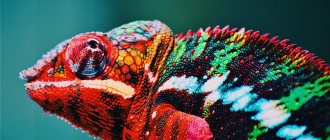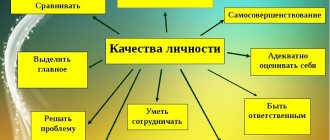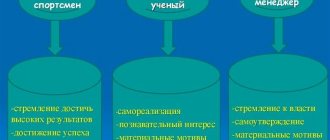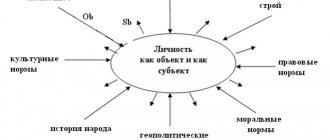Ontogenesis in psychology is the study of human mental development from the very fertilization of the egg to the last days of life. The biological phenomenon explains the realization in a child of genetic data from his ancestors at the morphological, physiological, and biochemical stages of development.
Ontogenesis reveals how the basic structures are formed in the child’s psyche - his consciousness and personality.
Ontogenesis - What is it in Psychology?
- 1. Conflicting opinions
- 2.Main steps
- 3.Emotional state
- 4.Examples from life, facts
- 5.Human driving force
- Very simple about the subconscious
- Dementia - what is this disease?
- Schizoid and Schizoid: Signs and Causes
- Butterfly Effect - What is it?
- Paraphrenic syndrome in schizophrenia. Clinical picture
Conflicting opinions
Initially, when scientists began to consider ontogenesis as a scientific subject, it caused a lot of controversy.
Theorists could not come to a consensus on how the pure soul of a child is influenced by his environment. How personality is formed under the influence of society, social groups and depends on:
- from upbringing;
- education;
- friends.
The question remains undisputed that events and life situations make people:
- evil or good;
- bad, good;
- honest, deceitful.
Scientists have put forward such a definition in the formation of personality as:
- genetic factor;
- heredity.
The human psyche is created by genes passed on from parents, and during the process the environment has minimal or no influence.
According to them, man grows and develops according to the laws of nature. This area should not be interfered with by outside forces. For reference:
Only psychologists of the present time have established that the concept of ontogenesis can be considered comprehensively.
The debate regarding the primary components in the form of genetics or environmental influences is pointless. Human consciousness and behavioral factors are created by:
- external environment;
- internal characteristics of the individual;
- the conditions in which the child grows up;
- heredity;
- the ability to realize one’s own fantasies under the prohibitions and norms of behavior in society.
In simple terms, the findings prove the complex process of human development during their maturation and socialization, which is equally influenced by psychological and biological traits.
Stages of development of child psychology
History of discovery and study
To understand how ontogenesis appeared and developed, you need to know the researchers who contributed to its study:
- Christian Pander - studied changes in a hatched egg over 5 days. Was able to study all stages (3) of separation of the layers of the egg before the chick hatches.
- Karl Baer - studied the embryonic development of animals. He published the book “The History of Animal Development. Observations and Reflections."
- Karl Gertner - studied plants, proved that plants have sex divisions.
- Wilhelm Hofmeister - proved the existence of fertilization in plants.
Researchers study the process of ontogenesis in both humans and animals and plants. This allows us to draw some analogies and establish clear distinctions.
Main stages
No matter how much the great minds of science argue, the human psyche remains the only, unique form in the entire animal world.
The study of its ontogenesis, clarity in the laws, and the development of the conscious organism provides a concept for regulating human behavior in society. People change depending on age in the process:
- growth;
- maturation;
- development;
- aging.
Universal age-related processes provide the foundation for the formation of individual differences.
Regardless of the change of generations, the same turn occurs:
- from infancy to adolescence, the child is forcibly influenced by adults, raised and taught;
- at the next stage there is personal self-realization, socialization with the help of elders;
- youth, the most productive period passes, the circle rapidly rolls down to the aging phase.
This is interesting:
The personality of each person develops in the same order as the history of mankind.
Archaeologists, paleontologists, and anthropologists have for a long time been engaged in proving the relatively close connection between childhood, youth, and maturity of society in a historical format, within the framework of the ontogenesis of entire generations. Socialization also goes through similar stages. Briefly, the psychological formation of all humanity and individual individuals is improved according to the same pattern.
The individuality of a person as an individual - what is it?
Emotional condition
Despite the fact that the human soul is in the dark, psychologists have traced the formation, the reaction to events with emotions.
Each age period has its own distinctive features:
- up to a year, people live according to the instincts provided by nature, where food prevails over the rest;
- within 3 years, the child determines what is good and bad, forms his attachments to his mother and nanny;
- basic emotions are manifested and created before adolescence, depend on the physiological state, and express an independent mental characteristic;
- After final maturation, this happens at different times for everyone, the formation of higher emotions occurs, the ability to manage, control and hide them is created depending on the event.
The human psyche is such a complex area, in the creation and upbringing of which internal and external factors and the entire spectrum of feelings take part.
Sleep disturbance changes emotional perception
Classification
In psychology, there are two types of ontogenesis - direct, indirect. The first represents the development of an adult organism without a period of metamorphosis. The second is the formation of a larva, which differs from adult organisms and transforms into them only after metamorphosis.
Straight
Subspecies:
- Non-larval type. Characteristic of fish, some invertebrates and mammals, birds, and reptiles. The embryo remains in the egg for a long time and develops there.
- Intrauterine type. It is inherent in humans and higher mammals. The main vital functions of developing embryos are carried out through the mother's body.
Indirect
This is a larval type inherent in some vertebrates and most species of invertebrate organisms. It represents several stages of larval development.
Often the larvae live on other large living beings, develop, and feed. This is a parasitic lifestyle that lower beings need to maintain their own organism.
Examples from life, facts
A person encounters the phenomenon of ontogenesis from the first days of his life.
Therefore, every fact in his fate will serve as an example. If you translate an incomprehensible term from Greek, it means the origin of existence. Which in itself speaks about all the transformations of a living organism, from fertilization to death. This concept includes different types of ontogenesis, but man, as the highest being in the world space, refers to the intrauterine one, which all mammals are endowed with.
At the embryonic stage, embryogenesis has a division, the following processes occur in it:
- 2 germ cells merge at the moment of fertilization, the parental genes are combined and a child is born;
- mitotic divisions begin in the cells before the formation of blastomeres, they are transformed into a blastula - a vesicular formation or embryo;
- at the stage of gastrulation, the germinal vesicle is overgrown with layers - mesoderm;
- During neurulation, some ectodermal cells are separated, forming a kind of neural layer that closes, the remaining ones are transformed into a neural crest.
- During the period of histogenesis, tissues - nervous, muscle - are created and restored.
- When organogenesis is completed, the remaining organs develop.
At the last postembryonic stage, various transformations occur in the body until the heart stops.
This stage is distinguished by a duration that exceeds all stages of development. Important!
The formation of a child’s mental state and health begins from the moment of fertilization, so expectant mothers are protected; doctors do not recommend disturbing their consciousness with negative events.
During intrauterine ontogenesis, the fetus is closely related to the mother.
Vital functions are ensured through it; the egg is not able to saturate it with nutritional materials. The mechanism connecting the woman in labor with the fetus is the placenta; it is formed within 100 days; active substances begin to flow after 5 months. The germinal membrane supports life and protects. This period ends with the birth of a child. From the first days, a baby needs full care and breastfeeding. It has been proven that the nurse’s anxiety is transmitted to the baby, and he begins to behave restlessly.
Periods of ontogenesis
There are proembryonic, embryonic, postembryonic, periods of ontogenesis.
Proembryonic
This period includes gametogenesis. The formation of the egg and sperm occurs during oogenesis and spermatogenesis, respectively. There is also an accumulation of RNA necessary for the synthesis of ribosomes. Eggs have their own characteristics, as they differ in the amount of yolk: small, medium, multi-yolk.
The distribution also varies from uniform to central. The isolecithal egg is characteristic of mammals, the centrally located one is characteristic of insects, and the eggs of freshwater animals, reptiles, and birds occupy an intermediate position. It is during this period that a redistribution of intracellular inclusions is noted.
Embryonic
The period occurs during intrauterine development. From a fertilized egg, a cell is formed that undergoes further division. From the third week, the formation of the notochord, neural and intestinal tubes (from the ectoderm and endoderm) occurs. The axial skeleton develops from mesoderm cells.
As a result of fragmentation, the fertilized egg forms a blastocyst, blastula and gastrula. At the gastrula stage, three germ layers are formed - ectoderm, mesoderm and endoderm. The middle germ layer gives rise to the entire vascular system, bone marrow, and blood. The inner leaf is the source of the digestive and respiratory systems. The interaction between cells is due to intercellular contacts through which metabolism occurs.
Postembryonic
After birth, the postnatal period begins. All organisms go through a stage of puberty. For all living things there is early and late ontogenesis (for both plants and animals).
Regarding humans, ontogenesis is defined as the alternation of main periods (presented briefly in the table below).
| Periods | Age |
| juvenile | up to 13 years old |
| sexual | 13-16 years old |
| youthful | 17-21 years old |
| mature | 22-59 years old |
| elderly | 60-76 years |
| senile | 77-90 years |
| longevity | 91 and above |
The driving force of man
Psychological science has always tried to answer what motivates people to achieve the highest degree of development, forces them to constantly improve, accumulate knowledge and react differently to the same events.
By observing ontogenesis, scientists discovered how everything in the world is connected. Personality, character development, and actions in society and family are influenced by upbringing methods, habitat, place of work and residence. You don't have to be a scientist to notice that if a woman led a hectic lifestyle during pregnancy, the child will be born the same way. Parents endowed with bad habits rarely fail to pass on their addictions to their offspring. What kind of psyche can you talk about with an alcoholic and drug addict if it is initially destroyed, and even skeptics cannot cancel genetic engineering.
Freud's followers appeared among theorists. The founder of psychoanalysis argued that ontogenesis, in psychology, is the natural desire of a person to receive only pleasures, only prohibitions restrain him from committing offenses.
What does the society of our state think? How often does the desire arise to follow the realities of life, to independently try to curb one’s own psyche, to refute Freudian theories regarding the weak-willed flow along the river of fate, to use a difficult change of direction? Even if the upbringing took place in unfavorable conditions and there was often a contingent of criminal elements nearby.
Kvartina Daria · 30 Sep, 2019
The concept of ontogenesis in psychology
The path of becoming an individual. Includes cognition and activity. The formation of a person is carried out under the influence of society. From childhood, a child learns to understand his social role.
Historically, psychology considers the development of the psyche and personality as a whole. Ontogenesis is part of the social process.











